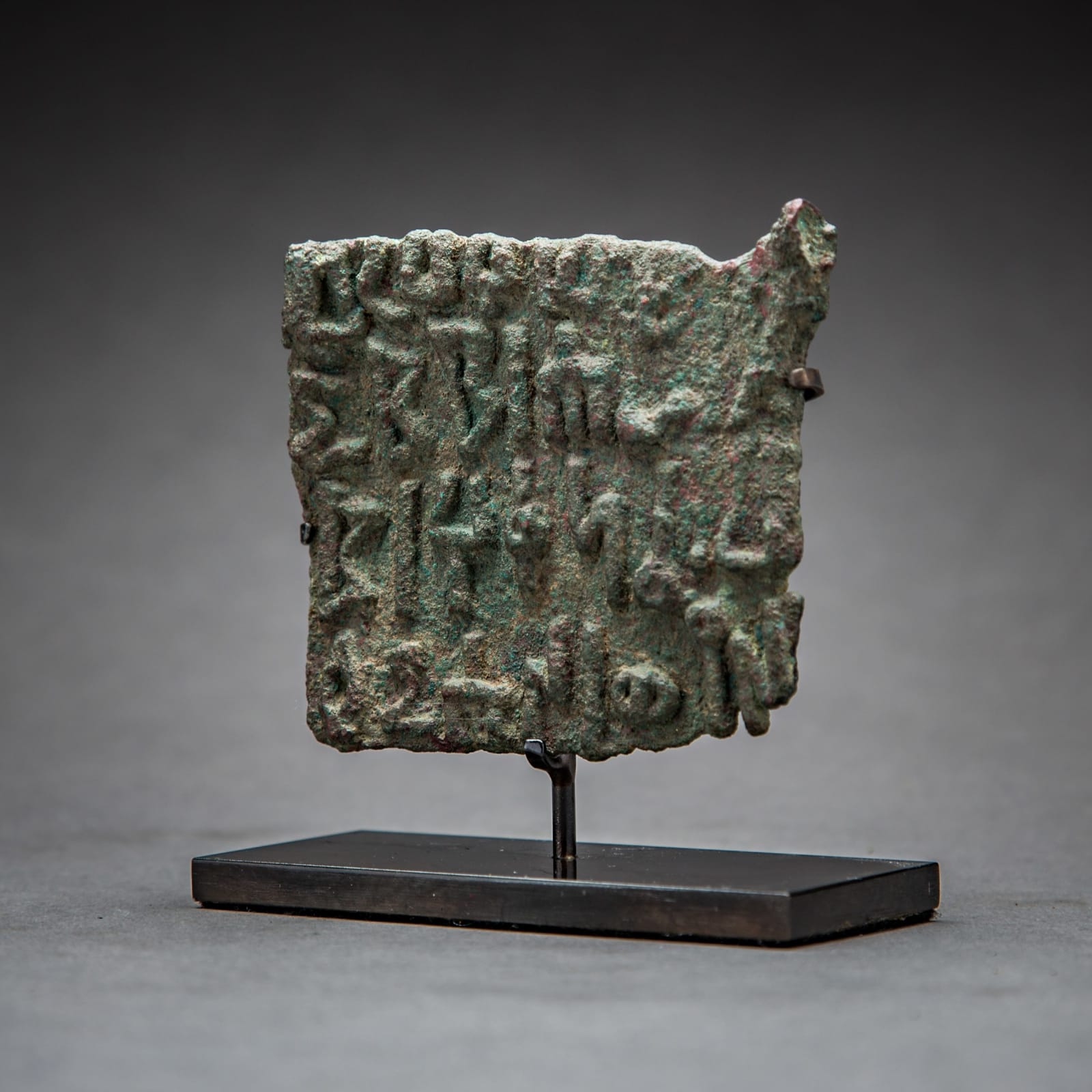Sabaean Inscribed Plaque, 300 BC - AD 100
Bronze
8.8 x 7 cm
3 1/2 x 2 3/4 in
3 1/2 x 2 3/4 in
LO.674
The ancient kingdom of Saba ruled over the lands of southern Arabia, centered in modern day Yemen. Saba is perhaps better known as Sheba, the Hebrew word for the kingdom,...
The ancient kingdom of Saba ruled over the lands of southern Arabia, centered in modern day Yemen. Saba is perhaps better known as Sheba, the Hebrew word for the kingdom, whose famous Queen was recounted as having visited Solomon in the pages of the Old Testament. Biblical accounts speak of the wealth of this ancient civilization of traders and merchants, and modern archaeological excavations confirm these reports. Ruins of fortresses and walled towns are evident and remnants of their extensive irrigation system that turned the desert into a paradise still cover the land. Although gold and silver deposits were present, the chief source of their vast wealth was derived from their veritable monopoly of two of the most coveted materials in ancient times: frankincense and myrrh, resinous gums obtained from certain trees that only grow in Southern Arabia and were literally worth their weight in gold. There was not a temple or wealthy house in the ancient world, from Babylon to Rome, where one would not smell the fragrant scents of these incenses. In addition, a trade route that connected India to Egypt that passed through their capital of Marib was another major source of wealth. Perhaps their greatest accomplishment was the Great Dam of Marib, a monumental construction that brought water from the mountains both to the city and to the crop fields. The dam was in continual use (accounting for timely repairs) until the 6th Century A.D. and its ultimate destruction is detailed in the Koran as the end of the old world and a turning point in history. However, the civilization that created this wonder fell apart long before the damn did. In the 1st Century A.D., the Ptolemaic Greeks discovered a sea route from India directly to the port of Alexandria, eliminating Saba from this lucrative trade and ushering in the decline of Sabean prosperity.
The tradition of placing dedicatory plaques on buildings is as old as history. With the birth of writing came the ability to praise and immortalize individuals through words. Such a practice is still prevalent in our society as we name our educational institutions and buildings after wealthy donors and as corporate names and logos grace our stadiums and arenas across the nation. Throughout time, in order to embark upon the great undertaking of erecting a building, the funds and financing had to be available. Whether provided by a wealthy merchant, a religious leader, or a king or emperor, we often associate buildings with people. Just think of Versailles or Monticello. This stunning bronze plaque is a testament to this ancient phenomenon. While we may like to believe patrons donate money out of the goodness of their hearts, there is often the motivation of fame and glory lurking beneath. One can achieve immortality through building a structure that lasts longer than us all. One such wealthy donor had this drive when he paid for this plaque, although in this case the dedication outlasted the building. Originally, the plaque would have been nailed or bolted to the wall of an ancient temple.
The tradition of placing dedicatory plaques on buildings is as old as history. With the birth of writing came the ability to praise and immortalize individuals through words. Such a practice is still prevalent in our society as we name our educational institutions and buildings after wealthy donors and as corporate names and logos grace our stadiums and arenas across the nation. Throughout time, in order to embark upon the great undertaking of erecting a building, the funds and financing had to be available. Whether provided by a wealthy merchant, a religious leader, or a king or emperor, we often associate buildings with people. Just think of Versailles or Monticello. This stunning bronze plaque is a testament to this ancient phenomenon. While we may like to believe patrons donate money out of the goodness of their hearts, there is often the motivation of fame and glory lurking beneath. One can achieve immortality through building a structure that lasts longer than us all. One such wealthy donor had this drive when he paid for this plaque, although in this case the dedication outlasted the building. Originally, the plaque would have been nailed or bolted to the wall of an ancient temple.



